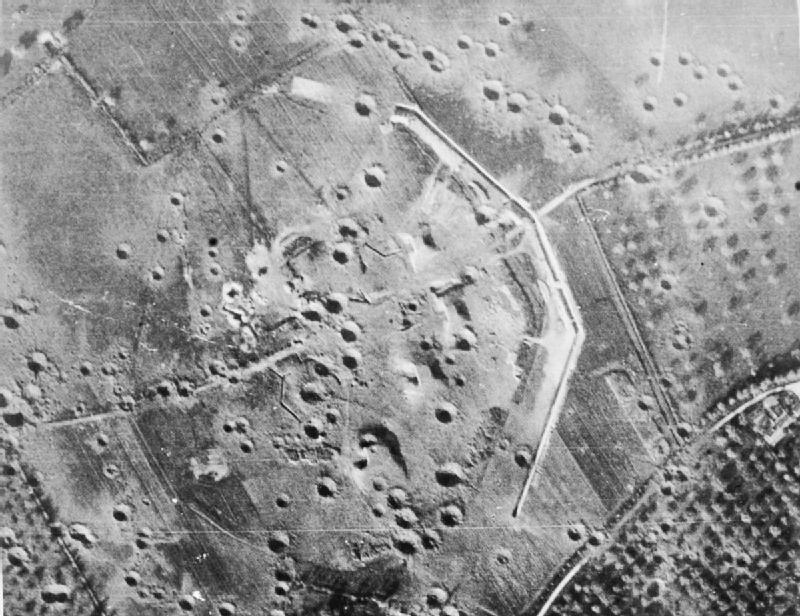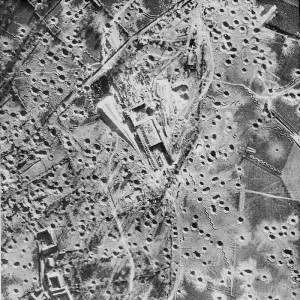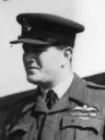7th Squadron Sorties June 1944 ~ RAF Oakington
Invasion Markings were defined in an April 1944 SHAEF (Supreme Headquarters Allied Expeditionary Force) Memorandum & were to be applied to Aircraft taking part in D-Day Operations as shortly as possible before the Assault. Stripes were applied beginning 3rd June 1944 using Distemper (a form of Whitewash used for temporary projects) in the Shades of ‘White’ & ‘Night’. The speed & manner of application (Brushes) led to some very scruffy Stripes. Neater examples were done, particularly on more Senior Officers’ Aircraft. Although Invasion Stripes were primarily for Protection against Allied Fire, they were not universally Appreciated. Reconnaissance (Mustang) & Observation (Auster) Aircraft Units objected to the compromise of their extremely important Camouflage. On 6th July 1944 an Order was signed allowing removal of Stripes from Upper Wing Surfaces & Fuselage Stripes down to the National Insignia. On 19th August 1944, SHAEF Oordered all Wing Stripes removed between 25th August & 10th September 1944. 2nd Tactical Air Force twin-Engined Aircraft (Mitchells, Boston & Mosquitos) were increasingly Attacked, especially at Night, by Allied Fighters; the twin-Finned Mitchells were particularly prone to Misidentification (Me.110 & Do.17). No Official Instruction was given, but by mid October 1944, full Fuselage (only) Stripes had been reapplied to 2nd TAF’s Medium Bombers.
3rd/4th June 1944 – Calais Lancaster lll NE123 MG-J (2.05)
127-Lancasters & 8-Mosquitos of No.s 1, 3 & 8-Groups continued the Deception Raids on Coastal Batteries at Calais & Wimereux. The Bombing was Accurate; no Aircraft Lost.
The fate of this Aircraft – Lost without a trace over the English Channel – On Friday, 25th August 1944, (a part of) the Aircraft of the 7th Squadron (RAAF), took off for a Mission to Brest in France from a Station (Airfield) in or near Oakington. One of the Crew Members was Flight Sergeant H Stenhouse RAAF. He departed for his Mission at 22:24. He flew with an Avro Lancaster (type III, with serial NE123 and code MG-J). His Mission and of the other Crew members was planned for Saturday, 26th August 1944.
5th/6th June 1944 – Merville/Franceville Lancaster lll ND590 MG-B (4.10-hrs) 1st Marker Target, Coastal Guns D-Day Beach
1,012- Aircraft – 551-Lancasters, 412-Halifaxes, 49-Mosquitos – to Bomb Coastal Batteries at Fontenay, Houlgate, La Pernelle, Longues, Maisy, Merville-Franceville, Mont Fleury, Pointe du Hoc, Ouisterham & St Martin de Varreville. 946-Aircraft carried out their Bombing Tasks. 3-Aircraft were Lost – 2-Halifaxes of No.4 Group on the Mont Fleury Raid & 1-Lancaster of No.6 Group on the Longues Raid. Only 2 of the Targets – La Pernelle & Ouisterham – were Free of Cloud; all other Bombing was entirely Based on Oboe Marking. At least 5,000-Tonnes of Bombs were dropped, the greatest Tonnage in one Night so far in the War.
Craig’s Aircraft Target was a Gun Battery at Merville-Franceville on the Normandy Coast 20-km Northeast of Caen. It was part of the German Defences known as the Atlantic Wall Built to Defend Western European Coasts from Invasion by the Allies. The 640M x 460M Battery Site was Located just Inland of the Coast with the forward Observation Bunker on the Beach on the East side of the Orne Estuary & they were Linked by an underground Armoured Telephone Cable. Together they controlled Maritime Access to Caen some 15-Km up the River Orne & the adjacent Canal de Caen a la Mer. The Allied Commanders had Designated the Battery as a Priority on D-Day objective because it directly threatened the Sword Beaches beyond the Orme Estuary to the West. It was Attacked a number of times by the RAF before D-Day. The Batteries Firepower consisted of WW1-vintage Czech M.14/19 100-mm Guns inside Massive Concrete Casemates covered with Soil & Grass to Blend in. There was also a Command Bunker, a Personnel Bunker, Machine Gun Emplacements, various Outbuildings & Shelters surrounded by Rows of barbed wire and an Anti-Tank Ditch on the Coast Facing side.

For more information see Battle of Merville Gun Battery
British, American & Canadian Divisions Landed on 5-Normandy Beaches early the next morning.
The Fate of this Aircraft MG-B. On Friday, 23rd June 1944, (a part of) the Aircraft of the 7th Squadron (RAAF), took off for a Mission to Coubronne, Ecques in France (V-1 Flying Bomb Launch Site) from a Station (Airfield) in or near Oakington. One of the Crew Members was Flight Lieutenant C H Drewer RAAF. He departed for his Mission at 00.02-hrs. He Flew with an Avro Lancaster (Type III, with Serial ND590 & Code MG-B). His Mission & of the other Crew Members was planned for Saturday, 24th June 1944. They did not Return.
7th/8th June 1944 – Massy-Palaiseau Lancaster lll ND387 MG-C (3.35) Visual Marking, Master Bomber W/C Baker
337-Aircraft – 195-Halifax’s, 122-Lancasters, 20-Mosquitos – Attacked Railway Targets at Achères, Juvisy, Massey-Palaiseau & Versailles. Bombing conditions were better than on the previous night. All Targets were accurately Bombed & although no details are available, it is probable that fewer Civilians were Killed. The Targets were mostly more Distant from the Battlefront than those recently Attacked & German Night Fighters had more time to Intercept the Bomber Forces. 17-Lancasters & 11-Halifax’s were Lost, 8.3% of the Forces Involved.
The Fate of this Aircraft ND387 MG-C 1651 CU – Attacked & Destroyed 3rd March 1945 by JU88 Night Fighter as part of the Stealth German Operation Gisela formulated to Shoot Down British Bombers Returning to Base.
In Early March 1945, the German Luftwaffe, in an isolated display of Resistance, developed a Tactic which, had it been deployed earlier, could have neutralised the WW2 Operations of RAF Bomber Command. In the early hours of 4th March 1945, in Unternehmen (Operation) Gisela, some 200 Junkers JU88 Night-Fighters of the Luftwaffe Nachtjagdeschwader Gruppen (Night Fighter Destroyer Group) had been deployed to Intercept the Allied Bombers returning to Base at their most vulnerable point, Just before Landing. The Marauding Aircraft crossed the North Sea at points stretching between the Thames Estuary & up the East Coast to the North Yorkshire Moors. The fact that these Intruders were able to Cross the North Sea Coast without being picked up by English Radar Operators would seem to have been a result of a degree of complacency that had set in amongst Bomber Command, as the Luftwaffe appeared to be Subdued.
8th/9th June 1944 – Fougeres Lancaster lll ND590 MG-B (4.55) Deputy Master Bomber (MB W/C Baker)
483-Aircraft – 286-Lancasters, 169-Halifax’s, 28-Mosquitos – Attacked Railways at Alençon, Fougères, Mayenne, Pontabault & Rennes to prevent German Reinforcements from the South reaching Normandy. All of the Raids appear to have been successful. 4-Aircraft were lost, 2-Lancasters from the Pontabault Raid & 1-Lancaster & 1-Mosquito from the Rennes Raid.
Fate of this Aircraft MG-B. On Friday, 23rd June 1944, (a part of) the Aircraft of the 7th Squadron (RAAF), took off for a Mission to Coubronne, Ecques in France from a Station (Airfield) in or near Oakington. One of the Crew Members was Flight Lieutenant C H Drewer RAAF. He Departed for his Mission at 00:02-hrs. He Jlew with an Avro Lancaster (Type III, with Serial ND590 & code MG-B). His Mission & of the other Crew Members was planned for Saturday, 24th June 1944. They did not Return.
10th/11th June 1944 – Dreux Lancaster lll ND852 MG-D (4.20) Deputy Master Bomber (MB Fl/Lt Irwin)
432-Aircraft – 323 Lancasters, 90 Halifax’s, 19 Mosquitos – attacked Railway Targets at Achères, Dreux, Orléans & Versailles. All targets were believed to have been hit but few further details are available. 15 Lancasters & 3 Halifax’s lost.
Fate of this Aircraft – This Aircraft was delivered to 32MU 30th March 1944 and issued to No.7 Squadron 6th April 1944. Between 18th & 20th June, it underwent local servicing and then continued in Service until its loss. ND852 wore the ID’s MG-G/D ND852 took part in the following Key Operations: As MG-G, Essen 26/27th April 1944, Mailly-le-Camp 3/4th May 1944, Duisburg 21/22nd May 1944, As MG-D, Rüsselsheim 25/26th August 1944. When Lost the Aircraft had a total of 262-hrs. On Friday, 25th August 1944, (a part of) the Aircraft of the 7th Squadron (RNZAF), Took off for a Mission to Bomb the Opel Factory in Russelsheim in Germany from a Station (Airfield) RAF Oakington. One of the Crew Members was Flight Lieutenant T H Strong DFC RNZAF. He Departed for his Mission at 20:59-hrs. He flew with an Avro Lancaster (Type III, with Serial ND852 & Code MG-D). His Mission and of the other Crew Members was planned for Saturday, 26th August 1944. Did not Return.
12th/13th June 1944 – Amiens Lancaster lll ND852 MG-D (3.15) Deputy Master Bomber (MB W/C Baker)
671-Aircraft – 348-Halifax’s, 285-Lancasters, 38-Mosquitos – of Nos 4, 5, 6 & 8-Groups to Attack Communications, mostly Railways, at Amiens/St Roch, Amiens/Longueau, Arras, Caen, Cambrai & Poitiers. (It is interesting to note that, with the exception of Caen, all of these Targets were the Sites of well-known Battles of earlier Wars & Caen was soon to be the scene of Fierce Fighting.) Bomber Command’s records state that the Poitiers Attack, by No.5 Group, was the most Accurate of the Night & that the 2-Raids at Amiens & the Raid at Arras were of reasonable Accuracy. The Target at Cambrai was Hit but many Bombs also fell in the Town. The most scattered Attack (also by No.5 Group) was at Caen. 23-Aircraft – 17-Halifax’s & 6–Lancasters – were Lost from these Raids; all of these Losses were from No.s 4 & 6-Groups.
The fate of this Aircraft see 10th June Log above

14th June 1944 – Le Havre Lancaster lll ND852 MG-D (2.45) Logbook denotes A J L Craig as Master Bomber it also notes (59 out of 70-Ships in this Target were Sunk).
The Major Port of Le Havre is on the Atlantic coast in North-west France.
221–Lancasters & 13-Mosquitos of No.1, 3, 5 & 8-Groups carried out Bomber Command’s 1st Daylight Raid since the Departure of No.2 Group at the end of May 1943. The objectives were the Fast German Motor-Torpedo Boats (E-Boats) & other Light Naval Forces Harboured at Le Havre which were threatening Allied Shipping off the Normandy Beaches only 30-miles away. The Raid took place in 2-Waves, 1st during the Evening & the 2nd at Dusk. Most of the Aircraft in the 1st Wave were from No.1-Group & in the 2nd Wave from No.3-Group. Pathfinder Aircraft provided Marking by their Normal Methods for both Raids. No unexpected Difficulties were encountered; the Naval Port area was accurately Bombed by both Waves with 1,230-tonnes of Bombs & few E-Boats remained undamaged. No.617 Squadron sent 22–Lancasters, each loaded with a 12,000-lb Tallboy Bomb, & 3-Mosquito Marker Aircraft to Attack the Concrete covered E-Boat Pens just before the 1st Wave Bombed. Several Hits were scored on the Pens & 1-Tallboy Bomb penetrated the Roof. This Raid was regarded as an experiment by Sir Arthur Harris, who was still reluctant to risk his Squadrons to the dangers of Daylight Operations but both Waves of the Attack were escorted by Spitfires of No.1 Group & only 1-Lancaster was Lost.
14th June 1944: Op 9: Lancaster R2: F/O Bennett/Crew
Pilot’s Comments: Le Harve ‘E’ Boat Docks on Target, in Broad Daylight. Flak thick Box Barrage. Intercom Useless. Bombed by visual Signals from Bomb Aimer. Fighter Cover of Spitfires. Bomb Load 13,000-lbs.
Navigator’s Comments: (Submarine Pens; Docks & Coastal Ships). Bomb Load 13000-lb HE. We had a Fighter Escort for the whole trip & actually Bombed at Dusk – up to this point all our Ops were at Night. We experienced Light & Heavy Flak. Our Intercom was unserviceable for the whole Flight – but we pressed on! Duration 4-hrs.
Mid-Upper Gunner’s comments: Le Harve, France. Target Harbour Installations, Ship & Submarine Pens. Bomb Load Cookie (4000-lbs) plus 1000-Pounders. Bombed at 16,000-ft. Reports given stated that 59 E-Boats were sunk in this engagement. Fairly Heavy Flak Opposition. No Fighters due to Semi-daylight Operation. The Intercom went useless 10-Mins from Target. Bomb Aimer used Sign Language for Bombing. Trip 4-hrs. All Aircraft returned. Incidentally, referring to Aircraft from Station. (Wickenby)
(59 out of 70 E-Boats Sunk at this Target))
The E-boat was the British term for the WW2 German Schnellboot (S-Boot), a small fast Torpedo Boat of approximately double the size of an American PT boat & the British MTB. It is believed that the E stood for “Enemy“. Compared to the Allied Craft, many considered that the E-Boats were better suited for the open Sea & had a substantially longer Range at approximately 700-Nautical Miles.
Fate of this Aircraft MG-D see 10th June Log
V-1 Flying Nomb or Doodlebugs: 13th June 1944 – On this Day the Germans Launched the 1st of their ‘V-Weapons’ (the ‘V‘ is Vergeltungswaffe, in English: Retaliatory Weapons or Reprisal Weapons) when 4 – V1’s, also known as ‘Doodlebugs’, Hit London. Around 30,000 V-Weapons would Bombard South-East Britain before the end of the War in May 1945. For the rest of the summer of 1944 RAF Bomber Command & the US Army Air Force added the V1 ‘Ski-site’ Launch Platforms & Storage Depots to their List of Targets they were Attacking daily: Barracks, Airfields & Railway Marshalling Yards.
On the Night 14th/15th June 1944, Flight Lieutenant J G Musgrave, the Pilot of a Mosquito of the County of Warwick Squadron (No.605) & his Observer, Flight Sergeant F W Samwell, were over the Channel. Soon after Midnight, they saw coming from the Continent what Musgrave inevitably described as a ‘Ball of Fire‘ It flashed past on our Starboard side a few 1,000-ft away & at the same height as we were Flying. I quickly turned to Port & chased it. It was going pretty fast, but I caught up with it & Opened Fire from Astern’. After 3-Bursts from his Cannon, ‘there was a terrific Flash & Explosion & the thing fell down in a vertical dive into the Sea. The whole show was over in 3-mins‘. The Flight Lieutenant was, in all probability, the 1st Member of the RAF to Shoot Down a Flying Bomb. This Weapon was one of the means by which Hitler hoped to restore the fallen Fortunes of the Reich. The other was the V2 Ballistic Rocket.
16th June 1944 – Renescure, Nr St Omar Lancaster lll ND906 MG-A (2.25-Hrs)
(Pas de Calais Tactical Target). A further Operation was planned for the 21st but the Log-book notes (Master Bomber had to Cancel the Raid – Low Stratus covered Target).
V1 Facility finished in November 1943 – 405-Aircraft – 236-Lancasters, 149-Halifaxes, 20-Mosquitos – of No.s 1, 4, 5, 6 & 8-Groups commenced the New Campaign against Flying-Bomb Launching Sites with Raids on 4-Sites in the Pas de Calais area. All Targets were accurately marked by Oboe Mosquitos & successfully Bombed. No Aircraft Lost.
The Fate of this Aircraft – Lancaster Bomber BIII, Serial No.ND906 MG-A of 7-Squadron, RAF, Crashed Church Lawford, Nr Daventry, Northants 5th May 1944 After taking Part in the Bombing Raid at Meersburg Oil Refinery, Germany. Aircraft Managed to get back to the UK but Crashed Killing all Onboard,
ND906 / MG-N of No.7 (Pathfinder) Squadron. RAF Oakington, Cambs. Crashed 5th May 1944, Ashby St Ledger, Nr Rugby, Warwickshire.
21st June 1944 – Pas-de-Calais Lancaster lll ND387 MG-C & O (2.40) Raid Cancelled Low Stratus
322-Aircraft – 165-Halifaxes, 142-Lancasters, 15-Mosquitos – 3, 6 & 8 Groups Attacked 3-No. V-1 Flying Bomb Sites. Because of Cloud, 2 of the Raids were abandoned after only 17-Aircraft had Bombed; the 3rd Target, at St Martin l’Hortier, was Bombed through 10/10ths Cloud. No Aircraft Lost.
23rd June 1944 – Courbronne Lancaster lll ND387 MG-C & O (2.15-hrs)
A J L Craig returns to the Role of Master Bomber on an Operation to Courbonne (V1 Flying Bomb Site Target)
The rough location of the V1 Launch Site at Courbronne, Ecques part of the Pas de Calais area in France.
The Route was Bradwell (Derbyshire), North Foreland (Kent Coast), Lattice B 10.65 (Eastern Chain – Gee Lattice Chart), Target, 5045N 0228E, 5105N 0230E, Orfordness (Suffolk Coast).
History of this Aircraft – MG-C ND387 was delivered to No.83 Sqdn 10th January 1944, to No.7 Sqdn 10th February 1944, to No.90 Sqdn 10th October 1944, to 1651CU 18th February 1945. Took part in the following Key Operations; With No.83 Sqdn No operations; With No.7 Sqdn as MG-C, Leipzig 19/20th February 1944; Schweinfurt 24/25th February 1944; Stuttgart 15/16th March 1944; Berlin 24/25th March 1944; As MG-O, Mailly-le-Camp 3/4th May 1944; With No.90 Sqdn, Nuremburg 19/20th October 1944; Attenben 14th February 1945-Daylight; with 1651CU-shot down by Intruder 3/4th March 1945. No record of Total hours. Shot down 01.15-hrs 4th March 45 Crashing near Woolfox Lodge Airfield, Rutland. Those Killed are buried in various Cemeteries in UK. Three are buried in Cambridge City Cemetery. F/S A Howard KIA Sgt A W Darling KIA Sgt W J Pullan KIA F/O K C Millar KIA F/S R B Wilson RNZAF KIA Sgt A W Taylor KIA Sgt J Thompson.

25th June 1944 – Abbeville (Goronflos) Lancaster lll ND387 MG-C (3.30-hrs) A J L Craig Master Bomber (V1 Flying Bomb Target) 30-mins spent at Woodbridge
323-Aircraft – 202-Halifax’s, 106-Lancasters, 15-Mosquitos – of No.s 1, 4, 6 & No.8 Group attacked 3-V1 Flying Bomb Sites. The weather was clear and it was believed that all 3-Raids were Accurate. 2-Halifax’s of No.4 Group were Lost from the Raid on the Montorgueil Site. No.617 Squadron sent 17-Lancasters, 2-Mosquitos & 1-Mustang to Bomb the Siracourt Flying-Bomb Store. The Mustang was Flown by Wing Commander Cheshire & used as a Low-level Marker Aircraft. The Mustang had only arrived at Woodhall Spa that afternoon, by Courtesy of the 8th Air Force & this was Cheshire’s 1st Flight in it. The Lancasters scored 3-Direct Hits on the Concrete Store with Tallboy Bombs and no Aircraft were Lost. W/C Cheshire had to make his 1st Landing in the unfamiliar Mustang when he returned to his Base Airfield after Dark.

